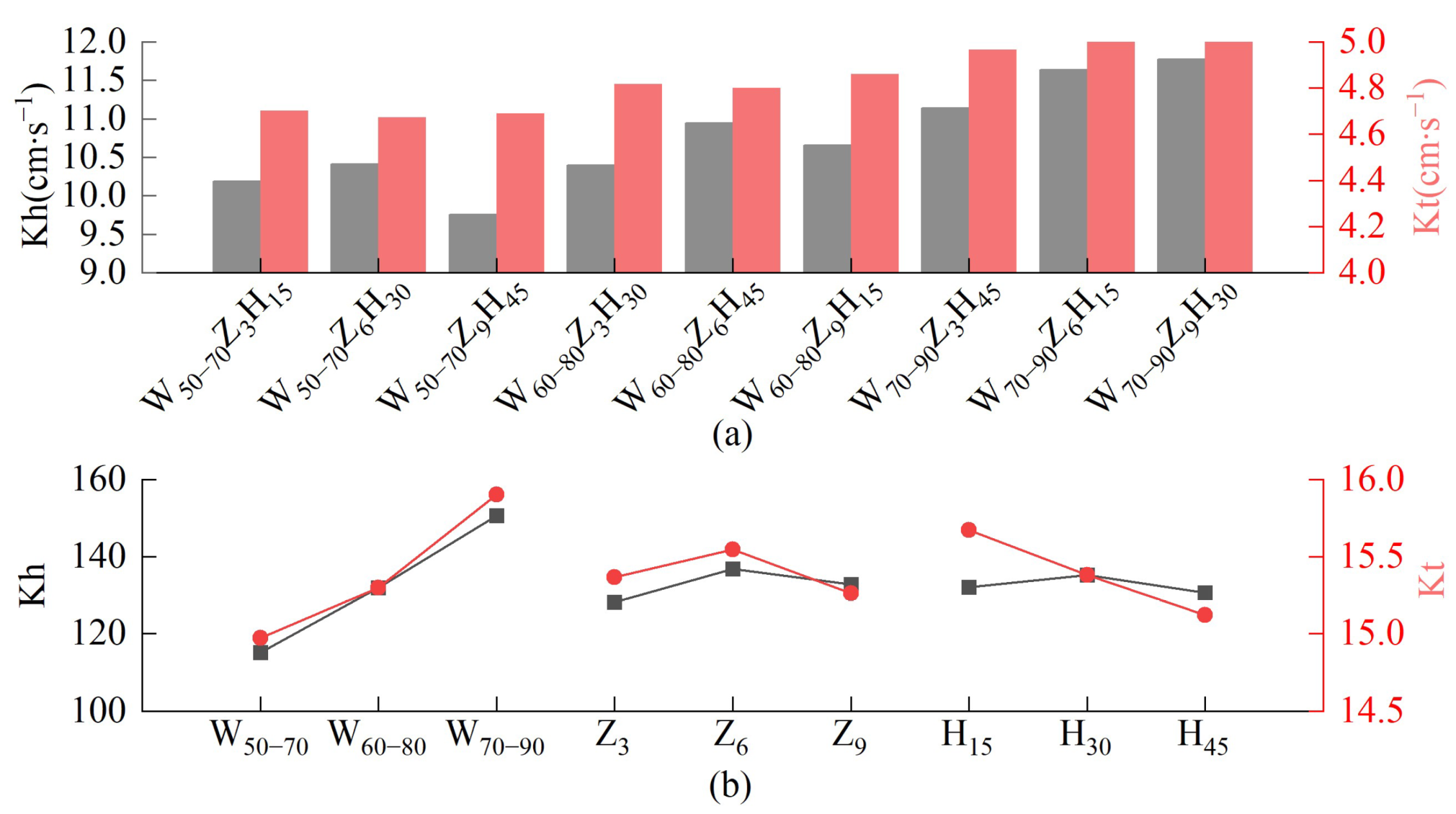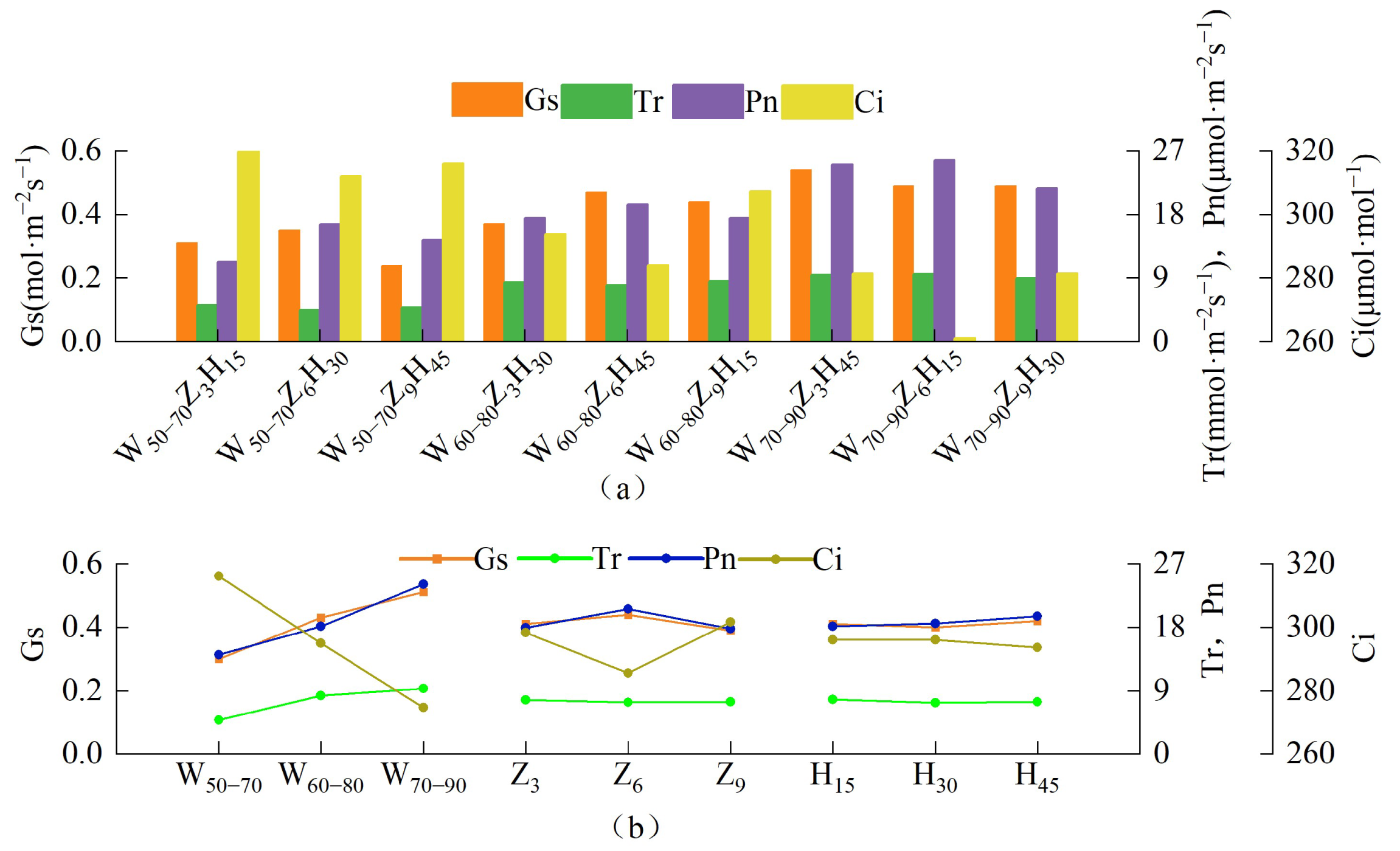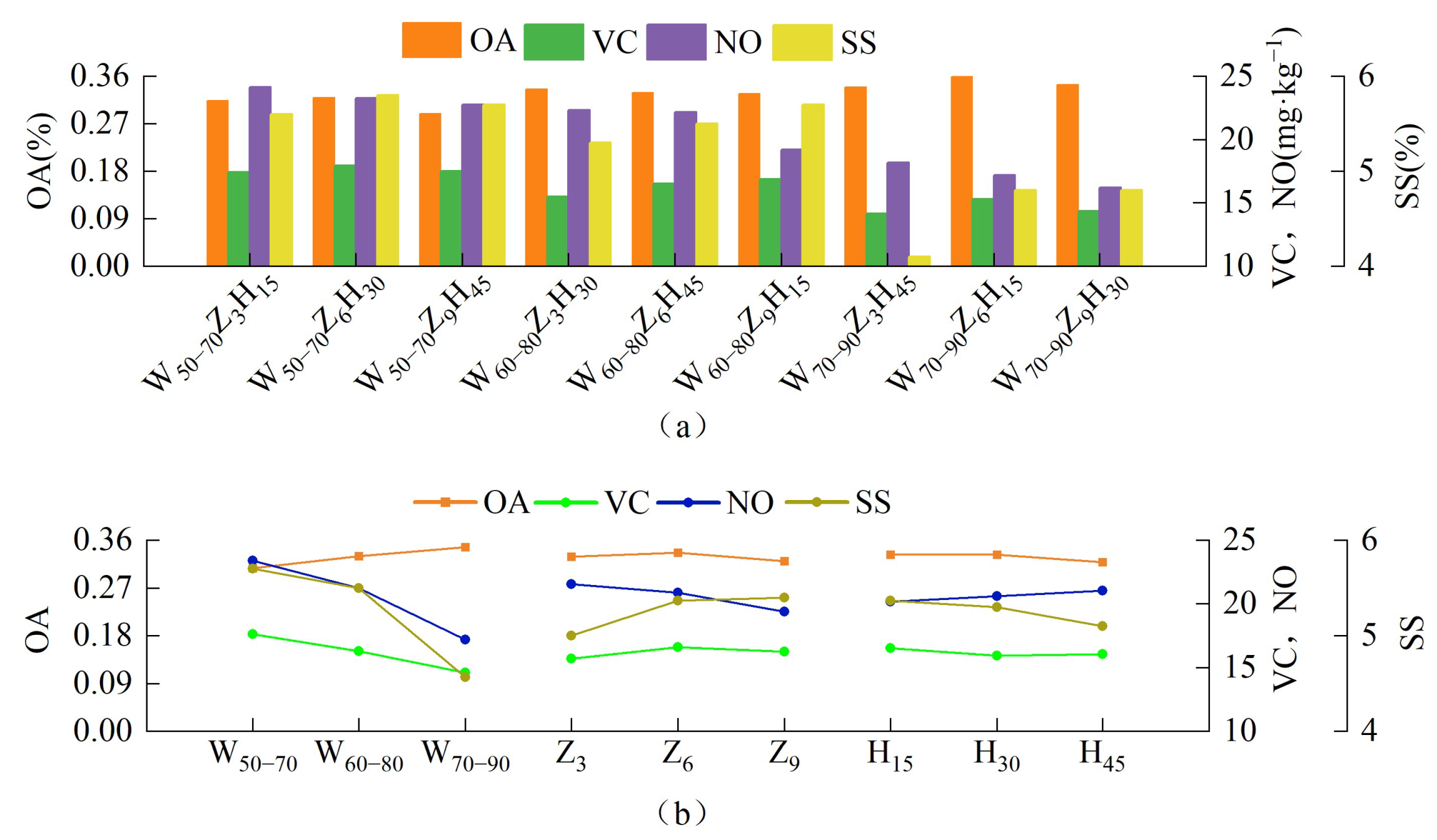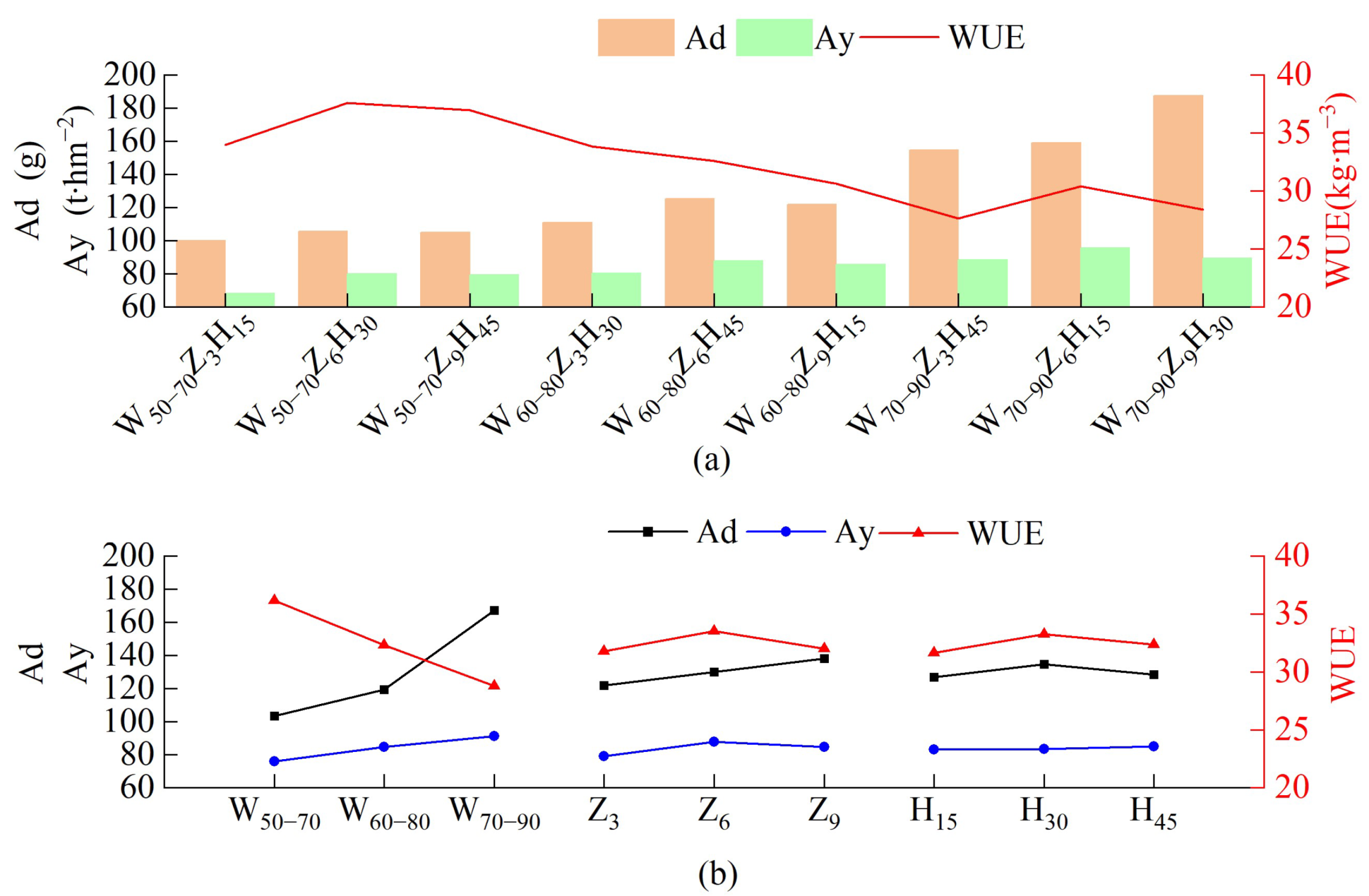The Effect of Water–Zeolite Amount–Burial Depth on Greenhouse Tomatoes with Drip Irrigation under Mulch
Abstract
1. Introduction
2. Materials and Methods
2.1. Experimental Site
2.2. Experimental Design
2.3. Measurement Parameters and Methods
2.4. Data Processing and Statistical Analysis
3. Results and Analysis
3.1. Effects of W*Z*H on the Tomato Growth and Physiological Characteristics
3.1.1. Effects of W*Z*H on the Tomato Plant Height and Stem Diameter
3.1.2. Effects of W*Z*H on Tomato Photosynthetic Characteristics
3.1.3. Effects of W*Z*H on Tomato Root
3.2. Effects of W*Z*H on the Tomato Nutritional Quality
3.3. Effects of W*Z*H on the Dry Matter Quality, Yield, and WUE of Tomatoes
3.4. Comprehensive Evaluation and Analysis of Tomato Planting
4. Discussion
4.1. Effects of Water Level on Tomato Growth
4.2. Effects of Zeolite Amount on Tomato Growth
4.3. Effects of Zeolite Burial Depth on Tomato Growth
4.4. Comprehensive Evaluation Analysis
5. Conclusions
Supplementary Materials
Author Contributions
Funding
Institutional Review Board Statement
Informed Consent Statement
Data Availability Statement
Acknowledgments
Conflicts of Interest
References
- Erba, D.; Casiraghi, M.C.; Ribas-Agusti, A.; Caceres, R.; Marfa, O.; Castellari, M. Nutritional value of tomatoes (Solanum lycopersicum L.) grown in greenhouse by different agronomic techniques. J. Food Compos. Anal. 2013, 31, 245–251. [Google Scholar] [CrossRef]
- Toor, R.K.; Savage, G.P.; Heeb, A. Influence of different types of fertilisers on the major antioxidant components of tomatoes. J. Food Compos. Anal. 2006, 19, 20–27. [Google Scholar] [CrossRef]
- Chapagain, A.K.; Orr, S. An improved water footprint methodology linking global consumption to local water resources: A case of Spanish tomatoes. J. Environ. Manag. 2009, 90, 1219–1228. [Google Scholar] [CrossRef] [PubMed]
- Wang, D.; Duan, H.; Huang, G.; Zhou, J.; Li, W.; Huang, R.; Fan, H. Effects of high temperature and drought stress on growth, nutrient concentration, and nutrient use efficiency of tomato seedlings. Acta Ecol. Sin. 2019, 39, 3199–3209. [Google Scholar]
- Xiao, H.-J.; Li, J.-Q.; Wang, J.-Q.; QJ, D. Effects of sub-low temperature and drought stress on water transport and morphological anatomy of tomato plant. J. Appl. Ecol. 2020, 31, 2630–2636. [Google Scholar]
- Yang, Z.; Qiu, Y.; Liu, Z.; Chen, Y.; Tan, W. The effects of soil moisture stress on the growth of root and above-ground parts of greenhouse tomato crops. Acta Ecol. Sin. 2016, 36, 748–757. [Google Scholar]
- Sepaskhah, A.; Barzegar, M. Yield, water and nitrogen-use response of rice to zeolite and nitrogen fertilization in a semi-arid environment. Agric. Water Manag. 2010, 98, 38–44. [Google Scholar] [CrossRef]
- Cui, X.; Song, J.; Qu, M. Effect of soil water potential on hydraulic parameters of Fraxinus mandshurica seedlings. Ying Yong Sheng Tai Xue Bao J. Appl. Ecol. 2004, 15, 2237–2244. [Google Scholar]
- Ramesh, K.; Reddy, D.D.; Biswas, A.K.; Rao, A.S. Zeolites and their Potential Uses in Agriculture. Adv. Agron. 2011, 113, 215–236. [Google Scholar]
- Amare, D.G. Review on Effect of Different Irrigation Method on Water Use Efficiency, Yield Productivity and Nitrogen Application. J. Biol. Agric. Health 2020, 10, 1–9. [Google Scholar]
- Gencoglan, C.; Akinci, I.E.; Akinci, S.; Gencoglan, S.; Ucan, K. Effect of different irrigation methods on yield of red hot pepper and plant mortality caused by Phytophthora capsici Leon. J. Environ. Biol. 2005, 26, 741–746. [Google Scholar]
- Lafrenière, C.; Surrage, V.; Dixon, M.; Zheng, Y. Evaluation of zeolite as a component in organic growing substrates for tomato transplant production. In Proceedings of the International Symposium on High Technology for Greenhouse Systems: GreenSys2009 893, Quebec City, QC, Canada, 14–19 June 2009; pp. 1215–1222. [Google Scholar]
- Sönmez, İ.; Kaplan, M.; Demir, H.; Yilmaz, E. Effects of zeolite on seedling quality and nutrient contents of tomato plant (Solanum lycopersicon cv. Malike F1) grown in different mixtures of growing media. J. Food Agric. Environ. 2010, 8, 1162–1165. [Google Scholar]
- Bernardi, A.C.; de Monte, M.B.M.; Paiva, P.R.P.; Werneck, C.G.; Haim, P.G.; de Barros, F.S. Dry matter production and nutrient accumulation after successive crops of lettuce, tomato, rice, and andropogongrass in a substrate with zeolite. Rev. Bras. Ciência Solo 2010, 34, 435–442. [Google Scholar] [CrossRef]
- Urbina-Sanchez, E.; Baca-Castillo, G.A.; Nunez-Escobar, R.; Colinas-Leon, M.T.; Tijerina-Chavez, L.; Tirado-Torres, J.L. Tomato seedlings soilless culture on K+, Ca2+ or Mg2+ loaded zeolite and different granule size. Agrociencia 2006, 40, 419–429. [Google Scholar]
- Bernardi, A.C.; Werneck, C.G.; Haim, P.G.; Botrel, N.; Oiano-Neto, J.; de Monte, M.B.M.; Verruma-Bernardi, M.R. Yield and fruit quality of tomato grown in substrate with zeolite. Hortic. Bras. 2007, 25, 306–311. [Google Scholar] [CrossRef]
- Zheng, J.L.; Chen, T.T.; Wu, Q.; Yu, J.M.; Chen, W.; Chen, Y.L.; Siddique, K.H.M.; Meng, W.Z.; Chi, D.C.; Xia, G.M. Effect of zeolite application on phenology, grain yield and grain quality in rice under water stress. Agric. Water Manag. 2018, 206, 241–251. [Google Scholar] [CrossRef]
- Ju, X.; Lei, T.; Guo, X.; Sun, X.; Ma, J.; Liu, R.; Zhang, M. Evaluation of Suitable Water–Zeolite Coupling Regulation Strategy of Tomatoes with Alternate Drip Irrigation under Mulch. Horticulturae 2022, 8, 536. [Google Scholar] [CrossRef]
- Rodrigues, M.Â.; do Torres, L.N.D.; Damo, L.; Raimundo, S.; Sartor, L.; Cassol, L.C.; Arrobas, M. Nitrogen use efficiency and crop yield in four successive crops following application of biochar and zeolites. J. Soil Sci. Plant Nutr. 2021, 21, 1053–1065. [Google Scholar] [CrossRef]
- Kurbanov, S.A.; Magomedova, D.S.; Dzhambulatova, A.Z. The influence of soil treatment and irrigation methods on tomato yield and quality in the lowlands of Dagestan. In Proceedings of the International Conference on World Technological Trends in Agribusiness (WTTA), Omsk, Russia, 4–5 July 2020. [Google Scholar]
- Rostami Ajirloo, A.; Amiri, E. Responses of tomato cultivars to water-deficit conditions (Case study: Moghan Plain, Iran). Commun. Soil Sci. Plant Anal. 2018, 49, 2267–2283. [Google Scholar] [CrossRef]
- Zhang, E.; Yan, W.; Hou, Y.; Zhang, S. Effect of Soil Amendments Used in Sandy Soil on the Photosynthetic Rate of Tomatoes. In Proceedings of the 3rd Conference on Horticulture Science and Technology (CHST 2012), Beijing, China, 24–25 November 2012; pp. 82–86. [Google Scholar]
- Niu, W.-Q.; Jia, Z.-X.; Zhang, X.; Shao, H.-B. Effects of Soil Rhizosphere Aeration on the Root Growth and Water Absorption of Tomato. Clean-Soil Air Water 2012, 40, 1364–1371. [Google Scholar] [CrossRef]
- Sun, W.H.; Liu, X.Y.; Wang, Y.; Hua, Q.; Song, X.M.; Gu, Z.; Pu, D.Z. Effect of water stress on yield and nutrition quality of tomato plant overexpressing StAPX. Biol. Plant. 2014, 58, 99–104. [Google Scholar] [CrossRef]
- Li, Q.; Wei, M.; Li, Y.; Feng, G.; Wang, Y.; Li, S.; Zhang, D. Effects of soil moisture on water transport, photosynthetic carbon gain and water use efficiency in tomato are influenced by evaporative demand. Agric. Water Manag. 2019, 226, 105818. [Google Scholar] [CrossRef]
- Aydiner, E.; Tuzel, Y.; Tuzel, I.H.; Tunali, U.; Oztekin, G.B. Effects of irrigation based on different moisture levels of growing medium on soilless grown greenhouse tomatoes. In Proceedings of the 6th Balkan Symposium on Vegetables and Potatoes, Zagreb, Croatia, 29 September–2 October 2014; pp. 93–98. [Google Scholar]
- Xia, X.-B.; Yu, X.-C.; Gao, J.-J. Effects of moisture content in organic substrate on the physiological characters, fruit quality and yield of tomato plant. J. Appl. Ecol. 2007, 18, 2710–2714. [Google Scholar]
- Jian, Z.; Xingyun, Q.; Cong, S.; Shaohong, Y.; You, W. Tomato Comprehensive Quality Evaluation and Irrigation Mode Optimization with Biogas Slurry Based on the Combined Evaluation Model. Agronomy 2022, 12, 1391. [Google Scholar]
- Dağdeviren, M.; Yavuz, S.; Kılınç, E. Weapon selection using the AHP and TOPSIS methods under fuzzy environment. Expert Syst. Appl. 2009, 36, 8143–8151. [Google Scholar] [CrossRef]
- Durbach, I.; Lahdelma, R.; Salminen, P. The analytic hierarchy process with stochastic judgements. Eur. J. Oper. Res. 2014, 238, 552–559. [Google Scholar] [CrossRef]
- Wu, X.; Wang, K.; Niu, X.; Hu, T. Construction of comprehensive nutritional quality index for tomato and its response to water and fertilizer supply. Trans. Chin. Soc. Agric. Eng. 2014, 30, 119–127. [Google Scholar]
- Wang, F.; Kang, S.; Du, T.; Li, F.; Qiu, R. Determination of comprehensive quality index for tomato and its response to different irrigation treatments. Agric. Water Manag. 2011, 98, 1228–1238. [Google Scholar] [CrossRef]
- Li, T.; Liu, L.-N.; Jiang, C.-D.; Liu, Y.-J.; Shi, L. Effects of mutual shading on the regulation of photosynthesis in field-grown sorghum. J. Photochem. Photobiol. B Biol. 2014, 137, 31–38. [Google Scholar] [CrossRef]
- Ye, Z.-Q.; Wang, J.-M.; Wang, W.-J.; Zhang, T.-H.; Li, J.-W. Effects of root phenotypic changes on the deep rooting of Populus euphratica seedlings under drought stresses. PeerJ 2019, 7, e6513. [Google Scholar] [CrossRef]
- Chen, X.; Wu, Q.; Gao, Y.; Zhang, J.; Wang, Y.; Zhang, R.; Zhou, Y.; Xiao, M.; Xu, W.; Huang, R. The Role of Deep Roots in Sorghum Yield Production under Drought Conditions. Agronomy 2020, 10, 611. [Google Scholar] [CrossRef]
- Dong, N.; Tang, M.-M.; Zhang, W.-P.; Bao, X.-G.; Wang, Y.; Christie, P.; Li, L. Temporal differentiation of crop growth as one of the drivers of intercropping yield advantage. Sci. Rep. 2018, 8, 3110. [Google Scholar] [CrossRef]
- Obregón-Portocarrero, N.; Díaz-Ortiz, J.E.; Daza-Torres, M.C.; Aristizabal-Rodríguez, H.F. Efecto de la aplicación de zeolita en la recuperación de nitrógeno y el rendimiento de maíz. Acta Agron. 2016, 65, 24–30. [Google Scholar] [CrossRef]
- Wu, Q.; Chen, T.; Chi, D.; Xia, G.; Sun, Y.; Song, Y. Increasing nitrogen use efficiency with lower nitrogen application frequencies using zeolite in rice paddy fields. Int. Agrophys. 2019, 33, 263–269. [Google Scholar] [CrossRef]
- Zhang, M.; Xiao, N.; Li, Y.; Li, Y.; Zhang, D.; Xu, Z.; Zhang, Z. Growth and Fruit Yields of Greenhouse Tomato under the Integrated Water and Fertilizer by Moistube Irrigation. Agronomy 2022, 12, 1630. [Google Scholar] [CrossRef]
- Zhao, J.; Hu, J.; Li, S. Selection of Irrigation Quota of Drip Irrigation under Film for Maize Based on Optimized AHP Method. J. Shenyang Agric. Univ. 2021, 52, 40–48. (In Chinese) [Google Scholar]
- Hernandez-Espinoza, L.H.; Barrios-Masias, F.H. Physiological and anatomical changes in tomato roots in response to low water stress. Sci. Hortic. 2020, 265, 109208. [Google Scholar] [CrossRef]
- Li, W.; Zhang, S.; Ding, S.; Shan, L. Root morphological variation and water use in alfalfa under drought stress. Acta Ecol. Sin. 2010, 30, 5140–5150. [Google Scholar]
- Li, Y.; Niu, W.; Cao, X.; Wang, J.; Zhang, M.; Duan, X.; Zhang, Z. Effect of soil aeration on root morphology and photosynthetic characteristics of potted tomato plants (Solanum lycopersicum) at different NaCl salinity levels. BMC Plant Biol. 2019, 19, 331. [Google Scholar] [CrossRef]
- Patel, D.; Das, A.; Munda, G.; Ghosh, P.; Bordoloi, J.S.; Kumar, M. Evaluation of yield and physiological attributes of high-yielding rice varieties under aerobic and flood-irrigated management practices in mid-hills ecosystem. Agric. Water Manag. 2010, 97, 1269–1276. [Google Scholar] [CrossRef]
- Heckman, J.; Kamprath, E. Potassium accumulation and corn yield related to potassium fertilizer rate and placement. Soil Sci. Soc. Am. J. 1992, 56, 141–148. [Google Scholar] [CrossRef]
- Petropoulos, S.A.; Fernandes, Â.; Xyrafis, E.; Polyzos, N.; Antoniadis, V.; Barros, L.; Ferreira, I. The optimization of nitrogen fertilization regulates crop performance and quality of processing tomato (Solanum lycopersicum L. cv. Heinz 3402). Agronomy 2020, 10, 715. [Google Scholar] [CrossRef]
- Wang, X.; Fan, J.; Xing, Y.; Xu, G.; Wang, H.; Deng, J.; Wang, Y.; Zhang, F.; Li, P.; Li, Z. The effects of mulch and nitrogen fertilizer on the soil environment of crop plants. Adv. Agron. 2019, 153, 121–173. [Google Scholar]
- Asch, F.; Dingkuhn, M.; Sow, A.; Audebert, A. Drought-induced changes in rooting patterns and assimilate partitioning between root and shoot in upland rice. Field Crops Res. 2005, 93, 223–236. [Google Scholar] [CrossRef]
- Zotarelli, L.; Scholberg, J.M.; Dukes, M.D.; Muñoz-Carpena, R.; Icerman, J. Tomato yield, biomass accumulation, root distribution and irrigation water use efficiency on a sandy soil, as affected by nitrogen rate and irrigation scheduling. Agric. Water Manag. 2009, 96, 23–34. [Google Scholar] [CrossRef]
- Zhang, S.; Wang, H.; Sun, X.; Fan, J.; Zhang, F.; Zheng, J.; Li, Y. Effects of farming practices on yield and crop water productivity of wheat, maize and potato in China: A meta-analysis. Agric. Water Manag. 2021, 243, 106444. [Google Scholar] [CrossRef]
- Chen, H.; Shang, Z.-H.; Cai, H.-J.; Zhu, Y. An Optimum Irrigation Schedule with Aeration for Greenhouse Tomato Cultivations Based on Entropy Evaluation Method. Sustainability 2019, 11, 4490. [Google Scholar] [CrossRef]
- Hao, S.; Cao, H.; Wang, H.; Pan, X. Effects of water stress at different growth stages on comprehensive fruit quality and yield in different bunches of tomatoes in greenhouses. Int. J. Agric. Biol. Eng. 2019, 12, 67–76. [Google Scholar] [CrossRef]
- Yi, F.; Li, C.; Feng, Y. Two precautions of entropy-weighting model in drought-risk assessment. Nat. Hazards 2018, 93, 339–347. [Google Scholar] [CrossRef]







| Organic Matter (g·kg−1) | Total Nitrogen (g·kg−1) | Available Phosphorus (g·kg−1) | Available Potassium (g·kg−1) | Available Nitrogen (g·kg−1) | PH |
|---|---|---|---|---|---|
| 15.32 | 1.12 | 0.02231 | 0.12032 | 0.05221 | 8.43 |
| Treatment | Soil Moisture Content (% Field Capacity) | Zeolite Amount (t·hm−2) | Zeolite Buried Deep (cm) |
|---|---|---|---|
| W50–70Z3H15 | 50–70 | 3 | 15 |
| W50–70Z6H30 | 50–70 | 6 | 30 |
| W50–70Z9H45 | 50–70 | 9 | 45 |
| W60–80Z3H30 | 60–80 | 3 | 30 |
| W60–80Z6H45 | 60–80 | 6 | 45 |
| W60–80Z9H15 | 60–80 | 9 | 15 |
| W70–90Z3H45 | 70–90 | 3 | 45 |
| W70–90Z6H15 | 70–90 | 6 | 15 |
| W70–90Z9H30 | 70–90 | 9 | 30 |
| Treatments | Kh | Kt | Pn | Tr | Rv | Rd | Ad | Ay | WUE | NO | SS | OA | VC |
|---|---|---|---|---|---|---|---|---|---|---|---|---|---|
| W50–70Z3H15 | 0.13 | 0.37 | 0 | 0.14 | 0 | 0 | 0 | 0 | 0.63 | 0 | 0.88 | 0.36 | 0.87 |
| W50–70Z6H30 | 0.25 | 0.23 | 0.37 | 0 | 0.27 | 0.20 | 0.07 | 0.44 | 1.00 | 0.11 | 1.00 | 0.43 | 1.00 |
| W50–70Z9H45 | 0 | 0 | 0.21 | 0.07 | 0.08 | 0.25 | 0.06 | 0.41 | 0.94 | 0.18 | 0.94 | 0 | 0.88 |
| W60–80Z3H30 | 0.34 | 0.39 | 0.43 | 0.75 | 0.59 | 0.65 | 0.13 | 0.45 | 0.62 | 0.23 | 0.71 | 0.66 | 0.35 |
| W60–80Z6H45 | 0.61 | 0.34 | 0.57 | 0.68 | 0.70 | 0.78 | 0.29 | 0.71 | 0.49 | 0.25 | 0.82 | 0.57 | 0.62 |
| W60–80Z9H15 | 0.44 | 0.41 | 0.43 | 0.79 | 0.52 | 0.50 | 0.25 | 0.64 | 0.30 | 0.62 | 0.94 | 0.54 | 0.72 |
| W70–90Z3H45 | 0.69 | 0.50 | 0.96 | 0.97 | 1.00 | 1.00 | 0.63 | 0.74 | 0 | 0.75 | 0 | 0.71 | 0 |
| W70–90Z6H15 | 0.82 | 1.00 | 1.00 | 1.00 | 0.87 | 0.90 | 0.68 | 1.00 | 0.28 | 0.88 | 0.41 | 1.00 | 0.31 |
| W70–90Z9H30 | 1.00 | 0.67 | 0.72 | 0.87 | 0.84 | 0.85 | 1.00 | 0.78 | 0.07 | 1.00 | 0.41 | 0.79 | 0.05 |
| Treatments | Growth and Physiology | Yield and Quality | Total Score | |||||||||||
|---|---|---|---|---|---|---|---|---|---|---|---|---|---|---|
| Kh | Kt | Pn | Tr | Rv | Rd | Ad | Ay | WUE | N | SS | OA | VC | ||
| W50–70Z3H15 | 0.02 | 0.03 | 0.00 | 0.00 | 0.00 | 0.00 | 0.00 | 0.00 | 0.09 | 0.00 | 0.05 | 0.03 | 0.04 | 0.21 |
| W50–70Z6H30 | 0.03 | 0.02 | 0.01 | 0.00 | 0.01 | 0.01 | 0.00 | 0.19 | 0.14 | 0.01 | 0.06 | 0.04 | 0.04 | 0.43 |
| W50–70Z9H45 | 0.00 | 0.00 | 0.00 | 0.00 | 0.00 | 0.01 | 0.00 | 0.18 | 0.13 | 0.02 | 0.05 | 0.00 | 0.04 | 0.35 |
| W60–80Z3H30 | 0.04 | 0.03 | 0.01 | 0.02 | 0.02 | 0.02 | 0.01 | 0.19 | 0.09 | 0.03 | 0.04 | 0.06 | 0.01 | 0.45 |
| W60–80Z6H45 | 0.07 | 0.03 | 0.01 | 0.02 | 0.03 | 0.03 | 0.02 | 0.31 | 0.07 | 0.03 | 0.05 | 0.05 | 0.03 | 0.55 |
| W60–80Z9H15 | 0.05 | 0.03 | 0.01 | 0.03 | 0.02 | 0.02 | 0.02 | 0.27 | 0.04 | 0.07 | 0.05 | 0.05 | 0.03 | 0.53 |
| W70–90Z3H45 | 0.08 | 0.04 | 0.02 | 0.03 | 0.04 | 0.04 | 0.04 | 0.32 | 0.00 | 0.08 | 0.00 | 0.06 | 0.00 | 0.59 |
| W70–90Z6H15 | 0.10 | 0.08 | 0.02 | 0.03 | 0.03 | 0.03 | 0.05 | 0.43 | 0.04 | 0.10 | 0.02 | 0.09 | 0.01 | 0.79 |
| W70–90Z9H30 | 0.12 | 0.06 | 0.02 | 0.03 | 0.03 | 0.03 | 0.07 | 0.34 | 0.01 | 0.11 | 0.02 | 0.07 | 0.00 | 0.71 |
| Treatments | Zhang’s Comprehensive Evaluation Model | Chen’s Comprehensive Evaluation Model | Hao’s Comprehensive Evaluation Model | |||
|---|---|---|---|---|---|---|
| Score | Ranking | Score | Ranking | Score | Ranking | |
| W50–70Z3H15 | 0.2125 | 9 | 0.3948 | 9 | 2.27146 | 9 |
| W50–70Z6H30 | 0.4321 | 7 | 0.4960 | 4 | 4.31386 | 8 |
| W50–70Z9H45 | 0.3521 | 8 | 0.4082 | 8 | 4.40933 | 7 |
| W60–80Z3H30 | 0.4478 | 6 | 0.4225 | 6 | 5.16473 | 6 |
| W60–80Z6H45 | 0.5499 | 4 | 0.5077 | 3 | 6.18221 | 5 |
| W60–80Z9H15 | 0.5314 | 5 | 0.4562 | 5 | 6.32204 | 4 |
| W70–90Z3H45 | 0.5878 | 3 | 0.4124 | 7 | 7.85353 | 3 |
| W70–90Z6H15 | 0.7949 | 1 | 0.6165 | 1 | 8.88215 | 1 |
| W70–90Z9H30 | 0.7146 | 2 | 0.6067 | 2 | 8.24633 | 2 |
Disclaimer/Publisher’s Note: The statements, opinions and data contained in all publications are solely those of the individual author(s) and contributor(s) and not of MDPI and/or the editor(s). MDPI and/or the editor(s) disclaim responsibility for any injury to people or property resulting from any ideas, methods, instructions or products referred to in the content. |
© 2023 by the authors. Licensee MDPI, Basel, Switzerland. This article is an open access article distributed under the terms and conditions of the Creative Commons Attribution (CC BY) license (https://creativecommons.org/licenses/by/4.0/).
Share and Cite
Zhang, M.; Lei, T.; Guo, X.; Liu, J.; Gao, X.; Lei, Z.; Ju, X. The Effect of Water–Zeolite Amount–Burial Depth on Greenhouse Tomatoes with Drip Irrigation under Mulch. Sustainability 2023, 15, 5220. https://doi.org/10.3390/su15065220
Zhang M, Lei T, Guo X, Liu J, Gao X, Lei Z, Ju X. The Effect of Water–Zeolite Amount–Burial Depth on Greenhouse Tomatoes with Drip Irrigation under Mulch. Sustainability. 2023; 15(6):5220. https://doi.org/10.3390/su15065220
Chicago/Turabian StyleZhang, Ming, Tao Lei, Xianghong Guo, Jianxin Liu, Xiaoli Gao, Zhen Lei, and Xiaolan Ju. 2023. "The Effect of Water–Zeolite Amount–Burial Depth on Greenhouse Tomatoes with Drip Irrigation under Mulch" Sustainability 15, no. 6: 5220. https://doi.org/10.3390/su15065220
APA StyleZhang, M., Lei, T., Guo, X., Liu, J., Gao, X., Lei, Z., & Ju, X. (2023). The Effect of Water–Zeolite Amount–Burial Depth on Greenhouse Tomatoes with Drip Irrigation under Mulch. Sustainability, 15(6), 5220. https://doi.org/10.3390/su15065220






